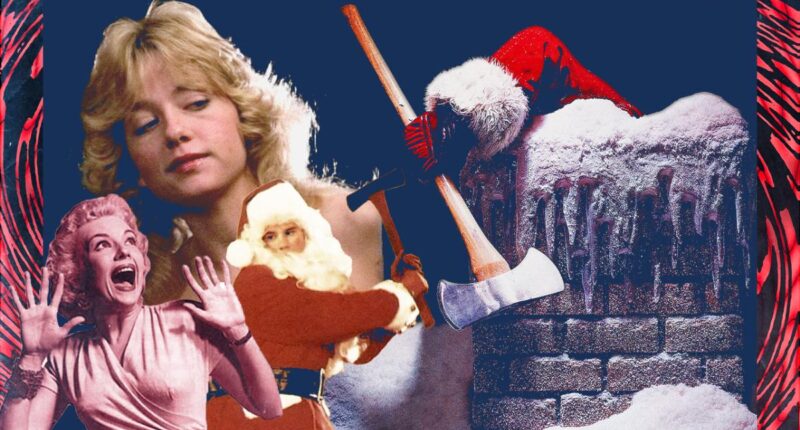For quite some time, Bad Santas have been a recurring theme in movies. The 2003 film Bad Santa starring Billy Bob Thornton is a prime example. In this movie, the Santa character portrayed by Thornton is deemed bad mainly due to his degenerate behavior, although there is a hint of redemption for him.
However, the concept of a psychotic and murderous Bad Santa is not as common as one might assume. Personal experience with such horror themes dates back to watching the 1972 movie Tales From The Crypt at the age of 12, well beyond the age of believing in Santa. The movie’s opening scene features Joan Collins facing a terrifying Santa-suited lunatic, making for a spine-chilling narrative. This storyline was adapted from a 1954 issue of the horror comic Vault of Horror, which caused controversy and nearly led to the censorship of comic books in the 1950s.
Another notable entry in the genre is the 1984 film Silent Night, Deadly Night, which takes the concept of a murderous Santa to a whole new level. This movie is so filled with gruesome violence that it can leave an enduringly distasteful impact on the viewer’s mind, ensuring that one might think twice before watching another psycho Santa film.
Partially it’s the nickel-book Freud stuff that underpins the narrative. This gets aired out directly after the goofy opening credits, featuring an animated wreath exploding in blood. A family in Utah drives out to a facility where little Billy (Jonathan Best) is left alone with his seemingly vegetative granddad (Will Best). Grampa snaps to life like an animatronic figure at Disneyworld, or Chuck E. Cheese, and gives Billy a portentous little lecture, like so: ”Heh heh…Santa Claus only brings present to them that’s been good all year…all the other ones… all the naughty ones…he PUNISHES.” Billy is suitably freaked out by this creepy old man who is nonetheless his blood kin. Worse is yet to come as an armed robber Santa waylays Billy’s family on the highway and rapes Billy’s mother before slashing her throat. No, I am not making this up and yes, this is the trauma that makes Billy way tetchy about the whole Santa Claus business.
Cut to a few years later, Billy is played by Danny Wagner, and he’s started lightening his hair, and when he’s compelled to sit on Santa’s lap in class, he gives the guy in the fat man costume such a haymaker that the bloody nose turns his white beard red in record time.
Where’s Billy been shacking up all this time? Why, in a Catholic orphanage. In Utah. No, really. Anyway, somewhere in the orphanage there’s a door with keyhole the Billy looks into and whaddya know, there’s two young people having sex. And then, before you can say boo, nun catches him, and gives him a good ruler whacking, averring, “Punishment is necessary. Punishment is good.” You see where this is going, right?
This elaborate variation on the Michael Meyers Origin Story from Halloween is building up to the fateful day when milk-drinking Billy, working in a department store, is ordered by the aging lushes who run the joint to play fat man for a day. Boy do they regret THAT casting choice. Among other things, Billy still flashes back to that keyhole vision, but now he fills it in with himself, getting down with current co-worker Pamela. So when Pamela sneaks off with a different male coworker to the “Employees Only” section of the store for some “Employees Only” action, you can count on Santa following them and giving them their punishment for naughty behavior.
Deadly Night was assembled by a lot of folks who were obscure before shooting, and remained obscure. The producers did want an established director, and they settled on Charles E. Sellier Jr., best known at the time for having produced the 1974 The Life and Times of Grizzly Adams, which spun off into a successful television series. Sellier took the gig but balked at the ultra-violent murder scenes, which were subsequently staged and shot, with a little too much relish, frankly, by editor Michael Steele. On the version of the picture I viewed via Amazon Prime, the image quality takes a severe downgrade at every murder, kind of like a worse version of the color desaturation at the climax of Scorsese’s Taxi Driver.
The movie contains one stab, so to speak, at humor. When Santa-suited Billy tells a wiggly brat on his lap “I don’t bring toys to naughty children. I punish them. Severely” she clams up and straightens out right quick, and an observing parent who didn’t hear him observes “He sure knows how to handle kids.” Also kind of funny, if you’re a particularly mean person, is when the cops almost shoot a Santa-suited father. “Daddy!” Yikes.
Eventually the narrative, as it always does with these kinds of pictures, accommodates a tired-looking police detective, who gets to the bottom of things.
Having relied on cheap gore “thrills” for most of its running time, the film tries for a suspense set piece finale but really has no business with such aspirations. It all comes back to that punishment-obsessed Mother Superior, of course, and she gets her teachable moment.
Unlike even the Crypt “bad Santa” episode and other pictures, this one seems to have a genuine antipathy to the legend and its attendant rituals. Not for any reason besides general prissiness and prissiness, I think. There’s a curious passage in the Wikipedia entry for the movie: “A Variety review argued that whatever arguments the film was making on the commercialism of Christmas were overshadowed by the graphic violence, which the reviewer saw as off-putting.“ There’s no link to said review and a “citation needed” note attached. Because, yeah, that never happened. There’s no commentary on the commercialism of the holiday. There is a however a sub-John-Parr song about how “it’s always Christmas on the warm side of the door.”
Taken as a whole, then, Silent Night, Deadly Night is a sodden squalid gorefest with zero redeeming social or artistic value. Two thumbs way up.
Veteran critic Glenn Kenny reviews new releases at RogerEbert.com, the New York Times, and, as befits someone of his advanced age, the AARP magazine. He blogs, very occasionally, at Some Came Running and tweets, mostly in jest, at @glenn__kenny. He is the author of the The World Is Yours: The Story of Scarface, published by Hanover Square Press, and now available for at a bookstore near you.
(function(d, s, id) {
var js, fjs = d.getElementsByTagName(s)[0];
if (d.getElementById(id)) return;
js = d.createElement(s); js.id = id;
js.src = “//connect.facebook.net/en_US/sdk.js#xfbml=1&appId=823934954307605&version=v2.8”;
fjs.parentNode.insertBefore(js, fjs);
}(document, ‘script’, ‘facebook-jssdk’));

















